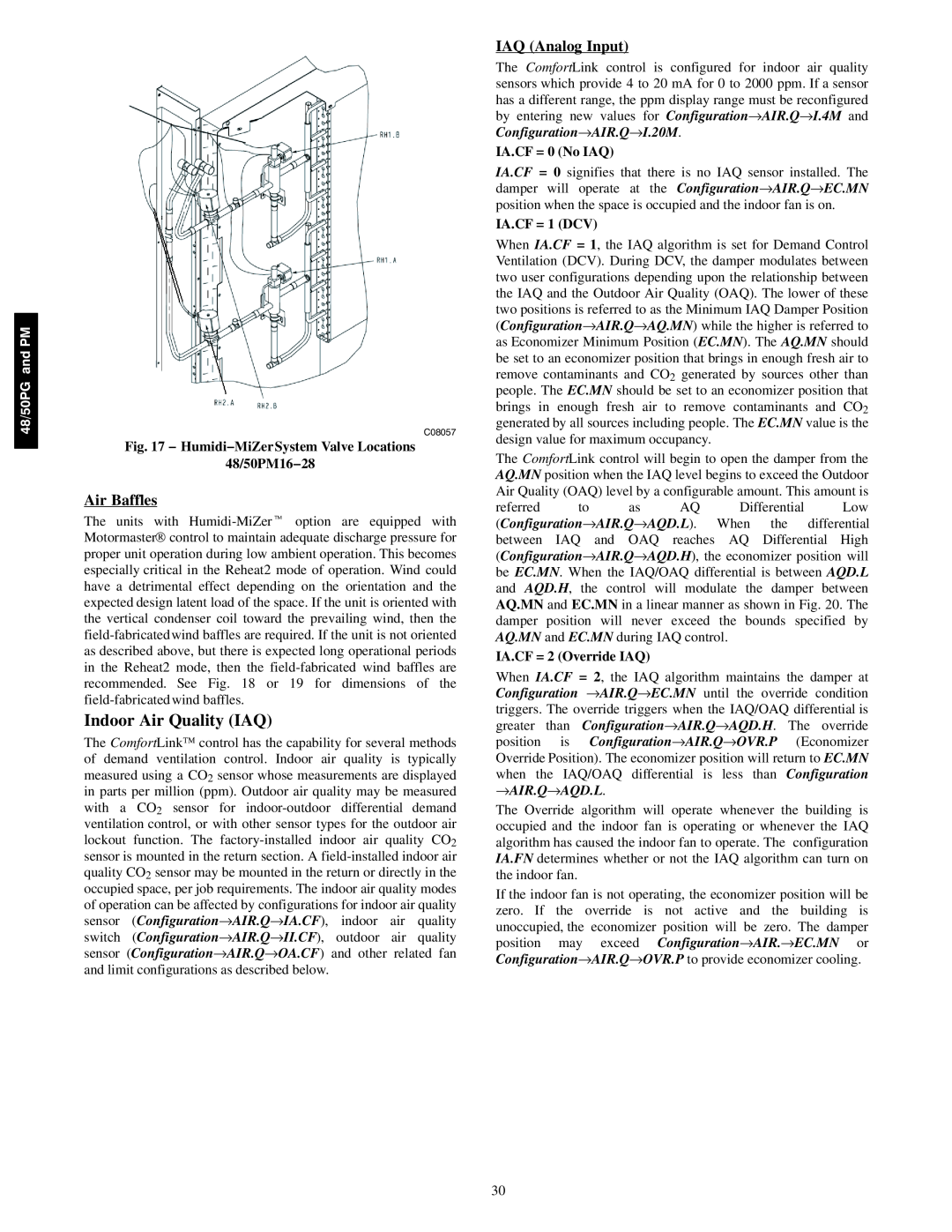
48/50PG and PM
C08057
Fig. 17 − Humidi−MiZer System Valve Locations
48/50PM16−28
Air Baffles
The units with
Indoor Air Quality (IAQ)
The ComfortLink control has the capability for several methods of demand ventilation control. Indoor air quality is typically measured using a CO2 sensor whose measurements are displayed in parts per million (ppm). Outdoor air quality may be measured with a CO2 sensor for
IAQ (Analog Input)
The ComfortLink control is configured for indoor air quality sensors which provide 4 to 20 mA for 0 to 2000 ppm. If a sensor has a different range, the ppm display range must be reconfigured by entering new values for Configuration→AIR.Q→I.4M and Configuration→AIR.Q→I.20M.
IA.CF = 0 (No IAQ)
IA.CF = 0 signifies that there is no IAQ sensor installed. The damper will operate at the Configuration→AIR.Q→EC.MN position when the space is occupied and the indoor fan is on.
IA.CF = 1 (DCV)
When IA.CF = 1, the IAQ algorithm is set for Demand Control Ventilation (DCV). During DCV, the damper modulates between two user configurations depending upon the relationship between the IAQ and the Outdoor Air Quality (OAQ). The lower of these two positions is referred to as the Minimum IAQ Damper Position (Configuration→AIR.Q→AQ.MN) while the higher is referred to as Economizer Minimum Position (EC.MN). The AQ.MN should be set to an economizer position that brings in enough fresh air to remove contaminants and CO2 generated by sources other than people. The EC.MN should be set to an economizer position that brings in enough fresh air to remove contaminants and CO2 generated by all sources including people. The EC.MN value is the design value for maximum occupancy.
The ComfortLink control will begin to open the damper from the AQ.MN position when the IAQ level begins to exceed the Outdoor Air Quality (OAQ) level by a configurable amount. This amount is
referred to as AQ Differential Low (Configuration→AIR.Q→AQD.L). When the differential between IAQ and OAQ reaches AQ Differential High (Configuration→AIR.Q→AQD.H), the economizer position will be EC.MN. When the IAQ/OAQ differential is between AQD.L and AQD.H, the control will modulate the damper between AQ.MN and EC.MN in a linear manner as shown in Fig. 20. The damper position will never exceed the bounds specified by AQ.MN and EC.MN during IAQ control.
IA.CF = 2 (Override IAQ)
When IA.CF = 2, the IAQ algorithm maintains the damper at Configuration →AIR.Q→EC.MN until the override condition triggers. The override triggers when the IAQ/OAQ differential is greater than Configuration→AIR.Q→AQD.H. The override position is Configuration→AIR.Q→OVR.P (Economizer Override Position). The economizer position will return to EC.MN when the IAQ/OAQ differential is less than Configuration →AIR.Q→AQD.L.
The Override algorithm will operate whenever the building is occupied and the indoor fan is operating or whenever the IAQ algorithm has caused the indoor fan to operate. The configuration IA.FN determines whether or not the IAQ algorithm can turn on the indoor fan.
If the indoor fan is not operating, the economizer position will be zero. If the override is not active and the building is unoccupied, the economizer position will be zero. The damper position may exceed Configuration→AIR.→EC.MN or Configuration→AIR.Q→OVR.P to provide economizer cooling.
30
